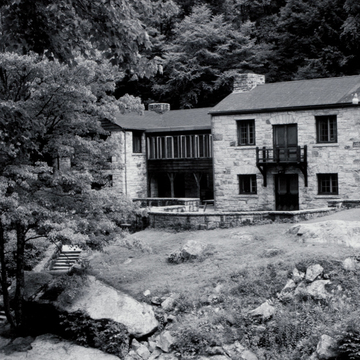Babcock is one of the earliest of West Virginia's state parks and easily one of the most picturesque. By the time E. V. Babcock deeded the property to the state in October 1934, nearby Camp Beaver had already been established to house Civilian Conservation Corps crews that would develop its facilities. In 1935 a second CCC facility, Camp Lee, was established to house additional workers. In addition to Babcock, enrollees at the two camps also built the first structures at nearby Hawks Nest State Park ( FY33).
The two-story Administration Building, built in 1935–1937 of sandstone laid in random rubble, is one of the CCC's major accomplishments in West Virginia. A sophisticated essay in rustic design, the main portion has much the same form as the nearby Old Stone House ( FY7), with massive interior end chimneys and a shallow-sloped gable roof. Stone and frame wings give the ensemble a broad U shape. The building still serves as park headquarters and also houses a restaurant and gift shop. A CCCconstructed terrace in front overlooks the original 1936 “swimming hole,” created by damming Glade Creek with a 150-foot stone and concrete dam. Stone steps that descend from the terrace to the water level blend with natural rock outcroppings.
Other CCC facilities at Babcock include the superintendent's residence, stables, and thirteen log cabins. Now supplemented with later cottages, the original cabins, numbered 1 through 13, are arranged in two clusters. All the cabins have exaggerated corner notching and porches supported by log columns, typical of the rustic style so popular at Depression-era parks. In 1975–1976 a water-powered gristmill was built near the Administration Building, using materials and parts from two dismantled mills. Named Glade Creek Mill, it is a tall, picturesque structure of clapboard with a boardand-batten shed-roofed wing. With its flume and overshot waterwheel, which operates in summer months, it presents the perfect picture of a once-familiar building type and is one of the state's most familiar and most photographed subjects.

